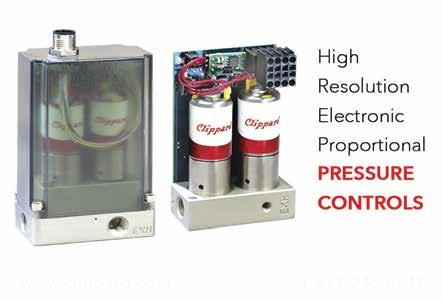TEST YOUR SKILLS
Understand the Application of Hydrostatic Systems The typical hydrostatic transmission consists of a closed circuit where a pump provides flow to a hydraulic motor without the use of directional valves. The ports of the pump are connected directly to the ports of the motor so that the flow from the pump drives the motor, and the discharge from the motor feeds the inlet to the pump. There are a number of valves included in the transmission package, but the main flow paths between the pump and motor are not restricted. The direction and speed of the motor is controlled by the flow from the pump. A bidirectional pump will provide a bidirectional motor. The pump and motor may be combined in a common housing or connected by plumbing when the motor is at some distance from the prime mover. The transmission produces a speed-torque ratio equal to the ratio of the motor and pump displacements. The motor can be a high-speed low torque, or a lowspeed high torque design. Fixed or variable displacement pumps and motors can be used to match the need of the application (see table). A common pump assembly consists of a hydromechanical, servo controlled, variable displacement, axial piston pump that is biased to zero displacement, with overcenter capabilities that allow it to vary and reverse the flow between the main two work ports while having a constant direction of input rotation. The pump assembly also includes a replenishing pump (sometimes referred to as a charge pump), a replenishing relief valve, and two replenishing check valves. The replenishing pump is typically 10% to 20% of the main pump displacement, although some applications may require greater replenishing displacement. The pump assembly may include ports to permit filtration of the replenishing flow and additional servo control valves. There are several ways to provide input to the servo displacement control: manually with a lever or linkage controlled by the operator, hydraulically using remote pilot pressure, or electrically using a proportional solenoid operated pressure reducing/relieving valve. Overpressure protection is accomplished by cross-port relief valves, a pressure compensator control that overrides the displacement 18
APRIL 2021
COMBINATION
APPLICATION
Fixed Pump + Fixed Motor
Constant speed. Torque and power vary with the load.
Fixed Pump + Variable Motor
Constant power. Flow to the motor is constant and motor displacement is varied to maintain the ratio of torque to speed. Increasing displacement to the motor increases torque capacity but speed decreases in inverse proportion (and vice-versa) so that the product of the two is constant power, proportional to the load pressure.
Variable Pump + Fixed Motor
Constant torque. Torque capacity is constant at any speed and is dependent only on the load pressure and motor displacement. Speed is a function of input flow. Variable power/torque/speed. Provides characteristics of both constant power and constant torque with nearly infinite ratios of both speed and torque to power.
Variable Pump + Variable Motor
With the pump at full displacement, decreasing motor displacement increases motor speed and torque decreases (and vice-versa) in inverse proportion (constant power). With the motor at maximum displacement, varying pump displacement varies speed and power output (constant torque).
Replenishing Relief Valve
Hot Oil Shuttle Directional Control Valve Hot Oil Shuttle Relief Valve
2 MPa (290 PSI) Main Pump
1.5 MPa (220 PSI) Replenishing Check Valves
Motor
Replenishing Pump
NOTE: Over-Pressure Protection and and NOTE: Overpressure protection servo control detailsdetails not shown. servo control not shown.
Figure 1: Simplified hydrostatic circuit in neutral.
command, or a combination of the two functions (figure 1). A hot oil shuttle package may be attached to the pump or motor or plumbed into the main work ports as an independent valve manifold. The hot oil shuttle package consists of a 3/3, closed center, pilot operated, spring centered, directional control valve and a low-pressure relief valve. The purpose of the hot oil shuttle is to allow some of the oil from the motor return to be directed to tank so additional fresh
replenishing fluid will be forced into the pump. This is necessary because the volume of fluid in the operating loop is usually a small fraction of the flow rate. In large systems, the fluid volume may be 1/10 of the flow rate. In close coupled pump-motor combinations, the ratio will be significantly smaller. Operating inefficiencies will quickly overheat the working fluid if it is not replaced by cool replenishing fluid (figure 2). During operation, when the main pump is in neutral at zero displacement, no fluid is flowing WWW.FLUIDPOWERJOURNAL.COM • WWW.IFPS.ORG






